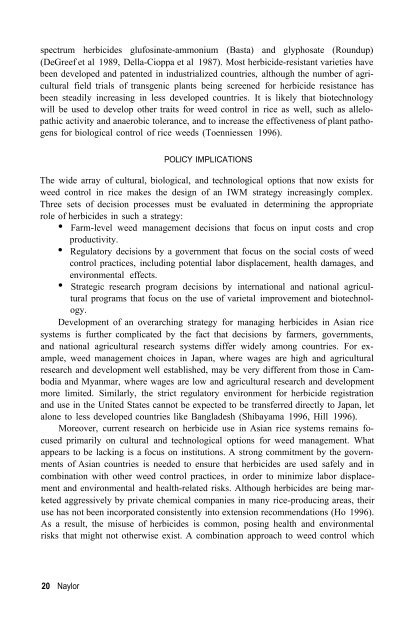HERBICIDES in Asian rice - IRRI books - International Rice ...
HERBICIDES in Asian rice - IRRI books - International Rice ...
HERBICIDES in Asian rice - IRRI books - International Rice ...
Create successful ePaper yourself
Turn your PDF publications into a flip-book with our unique Google optimized e-Paper software.
spectrum herbicides glufos<strong>in</strong>ate-ammonium (Basta) and glyphosate (Roundup)<br />
(DeGreef et al 1989, Della-Cioppa et al 1987). Most herbicide-resistant varieties have<br />
been developed and patented <strong>in</strong> <strong>in</strong>dustrialized countries, although the number of agricultural<br />
field trials of transgenic plants be<strong>in</strong>g screened for herbicide resistance has<br />
been steadily <strong>in</strong>creas<strong>in</strong>g <strong>in</strong> less developed countries. It is likely that biotechnology<br />
will be used to develop other traits for weed control <strong>in</strong> <strong>rice</strong> as well, such as allelopathic<br />
activity and anaerobic tolerance, and to <strong>in</strong>crease the effectiveness of plant pathogens<br />
for biological control of <strong>rice</strong> weeds (Toenniessen 1996).<br />
POLICY IMPLICATIONS<br />
The wide array of cultural, biological, and technological options that now exists for<br />
weed control <strong>in</strong> <strong>rice</strong> makes the design of an IWM strategy <strong>in</strong>creas<strong>in</strong>gly complex.<br />
Three sets of decision processes must be evaluated <strong>in</strong> determ<strong>in</strong><strong>in</strong>g the appropriate<br />
role of herbicides <strong>in</strong> such a strategy:<br />
• Farm-level weed management decisions that focus on <strong>in</strong>put costs and crop<br />
productivity.<br />
• Regulatory decisions by a government that focus on the social costs of weed<br />
control practices, <strong>in</strong>clud<strong>in</strong>g potential labor displacement, health damages, and<br />
environmental effects.<br />
• Strategic research program decisions by <strong>in</strong>ternational and national agricultural<br />
programs that focus on the use of varietal improvement and biotechnology.<br />
Development of an overarch<strong>in</strong>g strategy for manag<strong>in</strong>g herbicides <strong>in</strong> <strong>Asian</strong> <strong>rice</strong><br />
systems is further complicated by the fact that decisions by farmers, governments,<br />
and national agricultural research systems differ widely among countries. For example,<br />
weed management choices <strong>in</strong> Japan, where wages are high and agricultural<br />
research and development well established, may be very different from those <strong>in</strong> Cambodia<br />
and Myanmar, where wages are low and agricultural research and development<br />
more limited. Similarly, the strict regulatory environment for herbicide registration<br />
and use <strong>in</strong> the United States cannot be expected to be transferred directly to Japan, let<br />
alone to less developed countries like Bangladesh (Shibayama 1996, Hill 1996).<br />
Moreover, current research on herbicide use <strong>in</strong> <strong>Asian</strong> <strong>rice</strong> systems rema<strong>in</strong>s focused<br />
primarily on cultural and technological options for weed management. What<br />
appears to be lack<strong>in</strong>g is a focus on <strong>in</strong>stitutions. A strong commitment by the governments<br />
of <strong>Asian</strong> countries is needed to ensure that herbicides are used safely and <strong>in</strong><br />
comb<strong>in</strong>ation with other weed control practices, <strong>in</strong> order to m<strong>in</strong>imize labor displacement<br />
and environmental and health-related risks. Although herbicides are be<strong>in</strong>g marketed<br />
aggressively by private chemical companies <strong>in</strong> many <strong>rice</strong>-produc<strong>in</strong>g areas, their<br />
use has not been <strong>in</strong>corporated consistently <strong>in</strong>to extension recommendations (Ho 1996).<br />
As a result, the misuse of herbicides is common, pos<strong>in</strong>g health and environmental<br />
risks that might not otherwise exist. A comb<strong>in</strong>ation approach to weed control which<br />
20 Naylor

















